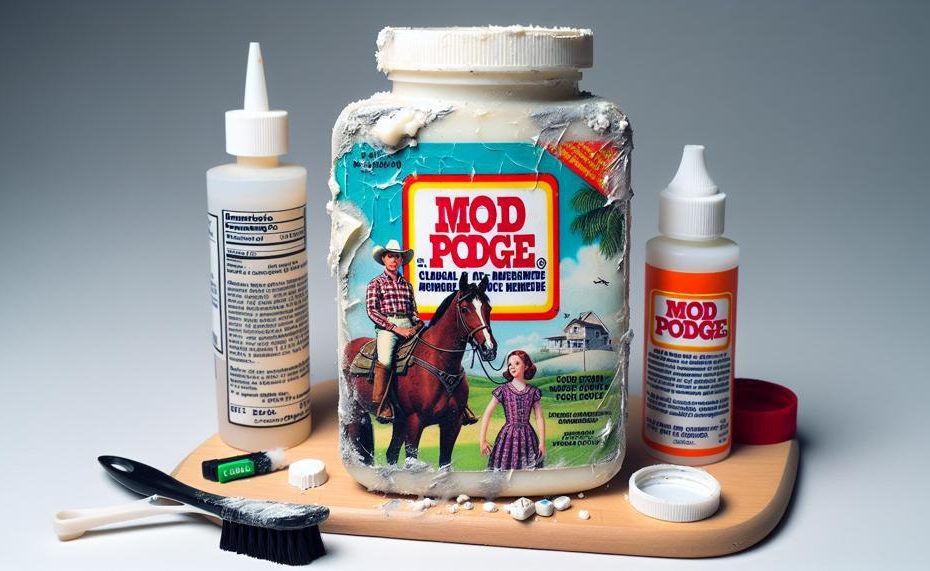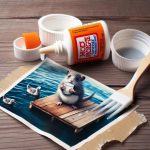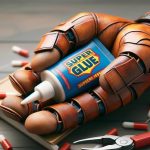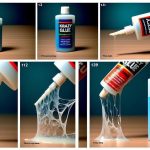Do you dread the sight of that sticky, shiny layer of Mod Podge on your latest crafting creation? Don’t worry, we’ve got you covered with our ultimate guide to removing Mod Podge without ruining your masterpiece.
Say farewell to those pesky brush marks and hello to a flawless finish with our step-by-step process.
In this blog post, we’ll cover everything you need to know, including:
- The importance of properly removing Mod Podge
- Essential materials for the removal process
- Detailed instructions for tackling wet and dry Mod Podge
- Tips and tricks for stubborn residue
- Alternative methods for removing Mod Podge
- Precautions when working with certain materials
- How to prevent future Mod Podge mishaps
Whether you’re a seasoned crafter or just starting out, this guide will help you achieve a smooth and professional look on all your projects.
So grab your supplies and get ready to bid adieu to that pesky Mod Podge.
Table of Contents
Does Mod Podge come off easily?
There are multiple methods available for removing Mod Podge from surfaces without causing damage. These include using isopropyl alcohol, warm soapy water, scraping and heat, and cleaners such as 409 or Goo Gone.
Each method has its own unique benefits and may work better for different surfaces or materials.
| Method | Description | Benefits |
| Isopropyl Alcohol | Moisten a cloth or sponge with isopropyl alcohol and gently rub the Mod Podge stain until it loosens and comes off. | – Highly effective on most surfaces – Gentle on delicate surfaces – Suitable for use on fabric |
| Warm Soapy Water | Create a soapy solution by mixing dish soap with warm water. Use a cloth or sponge to apply the solution to the Mod Podge stain and gently rub until it comes off. | – Safe for use on most surfaces – Can also be used on fabric – Ingredients are easy to find |
| Scrape and Heat | Remove excess Mod Podge with a scraper or knife. Heat some water in a pot and pour it over the Mod Podge residue. Use a scrub brush to brush off the remaining residue. Rinse with hot water and use a hose to wash away any remaining residue. | – Effective for removing large amounts of Mod Podge – Suitable for use on outdoor surfaces – No harsh chemicals required |
| Cleaners like 409 or Goo Gone | Apply a small amount of cleaner onto the Mod Podge stain and gently rub until it comes off. Wipe away any remaining residue with a damp cloth. | – Highly effective on most surfaces – Suitable for use on plastic – Quick and easy to use |
It is crucial to choose the right method based on the surface or material you are trying to remove Mod Podge from. For example, when working with glass, it is recommended to clean the surface before applying Mod Podge to make it easier to remove later on.
For plastic surfaces, it is best to use a plastic-safe adhesive remover. If dealing with fabric, using a damp cloth with warm soapy water may be the most effective option.
How to Remove Mod Podge
There are multiple strategies for eliminating Mod Podge from various surfaces, including using isopropyl alcohol, warm soapy water, heat, scraping, and specialized cleaners like 409 or Goo Gone.
Each of these methods can effectively remove Mod Podge residue, but certain techniques may work better on specific surfaces.
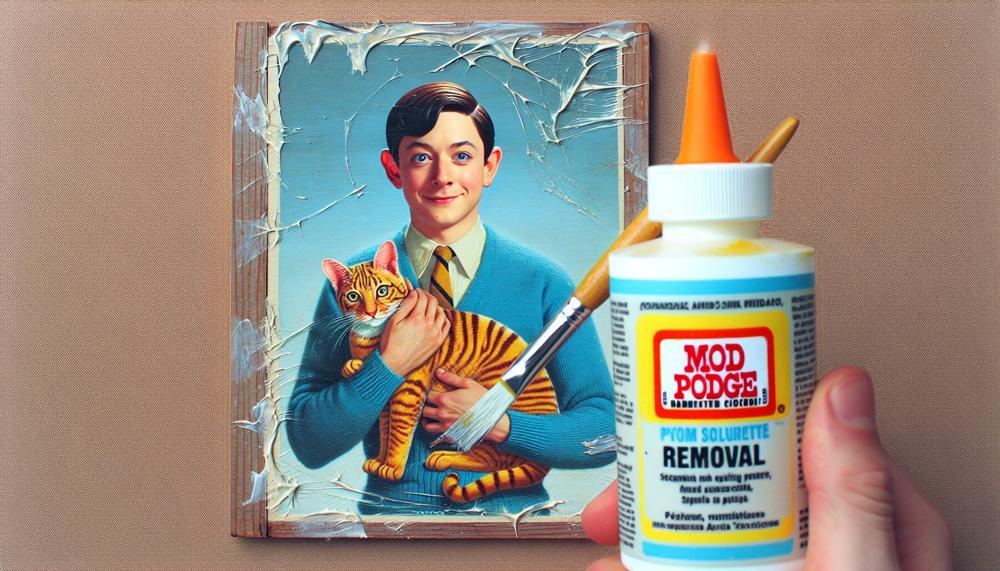
| Method | Instructions | Suitable Surfaces |
| Isopropyl Alcohol | – Dampen a cloth or sponge with isopropyl alcohol – Gently rub the Mod Podge stain until it loosens and comes off |
Glass, plastic, metal, fabric |
| Warm Soapy Water | – Mix dish soap with warm water to create a soapy solution – Dip a cloth or sponge into the solution – Gently rub the Mod Podge stain until it loosens and comes off |
Glass, fabric |
| Heat | – Heat water in a pot and pour over the Mod Podge residue – Use a scrub brush to brush off residues – Rinse with hot water and a hose if necessary |
Glass, metal, plastic |
| Scraping | – Remove excess Mod Podge with a scraper or knife | Any surface |
| Cleaners (409 or Goo Gone) | – Apply cleaner to a cloth or sponge – Gently rub the Mod Podge stain until it loosens and comes off – Rinse with clean water if necessary |
Any surface, may work better on plastic or metal |
Some additional tips for eliminating Mod Podge from specific surfaces include using a plastic-safe adhesive remover for plastic surfaces, using a damp cloth for fabric, using ammonia and dishwashing soap for tumblers, and using solvents and detergents for leather.
For dishwasher-safe Mod Podge, it can be removed with a dishwasher or steam cleaner. When removing from metal surfaces, it is recommended to test commercial paint and varnish remover or acetone/ethanol on an inconspicuous area first.
To remove from walls, mix soap and water and scrub with a sponge or cloth, then rinse with clean water. Rubbing alcohol may also work to remove Mod Podge but should be tested first.
How to Remove Mod Podge From Brush
Removing dried Mod Podge from a paintbrush can be a challenging task, but there are effective methods that can make it easier.
These techniques include soaking the brush in warm water and dish soap, using a vinegar and water mixture, applying heat, and using a specialized adhesive remover.
Each method has its own unique approach to removing Mod Podge, so let’s dive into the details of each one:
| Method | Description | Instructions |
| Soaking in Warm Water and Dish Soap | This method involves softening the Mod Podge with warm water and dish soap before gently scrubbing it off. | Fill a container with warm water and add a few drops of dish soap. Soak the paintbrush in the solution for at least 30 minutes. Gently scrub off the softened Mod Podge with a cloth or sponge. Rinse the brush with clean water and repeat if necessary. |
| Vinegar and Water Mixture | A mixture of vinegar and water can help loosen the adhesive, making it easier to scrape off. | Mix equal parts vinegar and warm water in a container. Dip the paintbrush in the solution and let it sit for a few minutes. Use a plastic scraper or old credit card to scrape off the Mod Podge. Rinse the brush with clean water and repeat if needed. |
| Applying Heat | This method involves using heat from a hairdryer or heat gun to soften the Mod Podge before scraping it off. | Hold the hairdryer or heat gun on low heat setting a few inches away from the brush. Move it back and forth over the Mod Podge for a few minutes. Use a plastic scraper or old credit card to scrape off the softened adhesive. Wipe the brush with a clean cloth or paper towel. |
| Commercial Adhesive Remover | A commercial adhesive remover specifically designed for glue or adhesive residues can also be used to remove Mod Podge. | Follow the manufacturer’s instructions for the specific product. Test the remover on a small area first to ensure it does not damage the brush. Apply the remover to the brush and let it sit for a few minutes. Use a cloth or sponge to gently scrub off the Mod Podge. Rinse the brush with clean water and repeat if necessary. |
How to Remove Mod Podge From a Puzzle
When faced with the task of removing Mod Podge from a puzzle, it’s crucial to proceed with caution to avoid damaging the puzzle pieces.
Here, we’ll outline the necessary steps for successfully removing Mod Podge without causing any harm.
| Step 1: | Lift and Scrape | Gently lift one edge of the puzzle at a time and use a sharp crafting knife or razor knife to scrape off the excess glue. Be sure to apply gentle pressure and avoid pulling on the pieces to prevent any damage. |
| Step 2: | Water and Brush | To remove Mod Podge stains, spritz warm water onto the affected area and use a plastic brush or scrubber with Vaseline or liquid soap. This will effectively scrub away the adhesive without harming the puzzle pieces. |
| Step 3: | Solvent Application | If previous methods fail, you can try using a solvent such as paint thinner or acetone. Wet the surface with the solvent and rub gently with a cloth until the Mod Podge is removed. |
| Step 4: | Clean up Residue | After successfully removing Mod Podge, be sure to clean up any residue with soap and water or rubbing alcohol. This will leave your puzzle looking clean and good as new. |
It is important to keep in mind that these methods may not be suitable for all types of puzzles. To ensure success, always test on a small inconspicuous area first before attempting to remove the adhesive from the entire puzzle.
Furthermore, it is crucial to use caution and gentle pressure when removing Mod Podge to avoid damaging the puzzle pieces.
How to Remove Mod Podge From Fabric
When it comes to removing Mod Podge from fabric, there are several methods that can be effective without causing damage. These include using dish soap, hot water, heat, and solvents.
However, it is important to note that different fabrics may require different removal methods.
| Dish Soap Method | Hot Water Method | Heat Method |
| The dish soap method involves saturating the hardened Mod Podge with liquid dish soap and allowing it to sit for 10-15 minutes before using a scrub brush to work out the glue and rinsing with cool water. | The hot water method requires soaking the fabric in the hottest water possible and allowing the Mod Podge to soften before scraping it off with a butter knife. Any remaining residue can be scrubbed away with dish soap. | The heat method involves using a hairdryer to warm up the Mod Podge, making it easier to scrape off with a fingernail. |
| Solvent Method | ||
| The solvent method involves using a paint thinner or acetone, but it should always be tested first on an inconspicuous area as it may cause damage to certain fabrics. |
For delicate fabrics, it is best to avoid solvents and opt for gentler methods such as dish soap or hot water. As an added precaution, always test any removal method on a hidden area before applying it to the entire surface to prevent potential damage or discoloration.
Other helpful tips for removing Mod Podge from fabric include using a damp cloth for scrubbing, using plastic-safe adhesive remover for plastic surfaces, and using a mixture of ammonia and dishwashing soap for tumblers.
For metal surfaces, a commercial paint and varnish remover may be effective, but it should also be tested first.
How to Remove Mod Podge From Wood
Removing Mod Podge from wooden surfaces can be a daunting task, but fear not, for there are several effective methods that can help you accomplish this task safely and successfully. Let’s explore some of the best techniques for removing Mod Podge from wood:
- Solvents like paint thinner and acetone – These potent solvents can effectively break down the dried Mod Podge, making it easier to remove. To use, simply apply a small amount of the solvent onto a cloth and gently rub it onto the affected area until the glue starts to dissolve.
- Hot water – Another great method is to use heat to soften the Mod Podge, making it easier to remove. You can either soak the surface in hot water or use a hairdryer to warm up the affected area.
- Scrubbing with a toothbrush or scrubber – For tougher spots of Mod Podge, using a toothbrush or scrubber can help loosen it from the surface. Be sure to use gentle pressure and avoid scrubbing too hard as this may damage the wood.
- Preparing the surface before applying Mod Podge – Prevention is key. Before using Mod Podge, make sure to thoroughly clean and dry the surface. This will prevent excess glue from sticking and make removal easier.
- Adhesive removers – There are also specialized adhesive removers designed specifically for removing Mod Podge. These products can be found at most craft stores and are safe to use on wood surfaces.
- Soapy water – If solvents or adhesive removers are not available, using hot soapy water can also be effective in removing Mod Podge from wood surfaces. Simply soak a cloth in hot soapy water and gently rub the affected area until the glue starts to come off.
Remember to always test any products or methods on a small, inconspicuous area first before using them on larger areas. This will help prevent any potential damage to the wood. With these techniques, you can efficiently and safely remove Mod Podge from wooden surfaces without causing any harm.
Using natural and environmentally-friendly methods is always a plus when it comes to removing Mod Podge. In fact, using hot vinegar is an excellent alternative to harsh solvents. Simply warm up white vinegar and apply it to the affected area before scrubbing it off with a soft cloth. This method is not only effective but also eco-friendly.
If you’re looking for a more creative approach, using mayonnaise can also be a great solution. The oils in mayonnaise can help loosen the glue from the wood. Simply apply a small amount of mayonnaise onto the affected area, let it sit for a few minutes, then wipe it off with a damp cloth.
As you can see, there are several methods available for removing Mod Podge from wood surfaces.
How to Remove Mod Podge From Plastic
If you’ve accidentally smeared Mod Podge on a plastic surface, don’t panic. There are several effective methods for removing it. Here are some proven ways to remove Mod Podge from plastic surfaces:
| Method | Description | Steps |
| Isopropyl Alcohol | One way to remove Mod Podge is by using isopropyl alcohol. Dampen a cloth or sponge with the alcohol and gently rub the stain until it loosens and comes off. | Dampen a cloth or sponge with isopropyl alcohol. Gently rub the Mod Podge stain until it loosens and comes off. Repeat if necessary. |
| Warm Soapy Water | You can also mix dish soap with warm water to create a soapy solution. Apply the solution to the stain using a cloth or sponge and gently rub until it comes off. | Mix dish soap with warm water to create a soapy solution. Apply the solution to the Mod Podge stain using a cloth or sponge. Rub gently until the stain lifts. Rinse with clean water and dry. |
| Scrape and Heat | If there is excess Mod Podge on the plastic, you can scrape it off with a scraper or knife before using hot water to loosen and wash away the remaining residue. | Scrape off any excess Mod Podge using a scraper or knife. Heat water in a pot and pour it over the residue. Use a scrub brush to brush off the residues. Rinse with hot water and use a hose to wash away any remaining residue. |
| Dishwasher or Steam Cleaner | For dishwasher-safe Mod Podge, you can use a dishwasher or steam cleaner to remove it from plastic surfaces. | Place the object in a dishwasher or steam cleaner. Run the cleaning cycle as usual. Check if the Mod Podge has been removed. Repeat if necessary. |
| Goo Gone or 409 | If none of the above methods work, you can try using Goo Gone or 409 cleaners. These contain special ingredients that can break down and remove even the strongest glue ties. | Spray Goo Gone or 409 on the glue spot. Wait 15-30 minutes for it to break down the glue. |
How to Remove Mod Podge From Glass
When it comes to removing Mod Podge from glass surfaces, it can be quite a challenging task. However, there are various effective methods that can make this process much easier and hassle-free. So, let’s take a look at some techniques you can try out:
| Method | Description | Instructions |
|---|---|---|
| Warm water and plastic brush | This method is best for wet Mod Podge and can be used on both small and large areas. | Immerse the glass surface in warm water for 5-10 minutes.
Use a plastic brush to gently scrub off the Mod Podge from the surface. Rinse with clean water and dry with a cloth. |
| Soaking in warm water or alcohol | This method is ideal for dried Mod Podge on larger areas. | Soak the glass surface in warm water or rubbing alcohol for 10-15 minutes.
Use a cloth or sponge to wipe off the softened Mod Podge. If needed, repeat the process until all Mod Podge is removed. Rinse with clean water and dry with a cloth. |
| Scribing with a toothbrush | This method works best for removing dried Mod Podge from small areas or intricate surfaces. | Dip a toothbrush in warm water and use it to gently scrape off the dried Mod Podge.
For tougher spots, use a toothpick to carefully remove any excess glue. Rinse with clean water and dry with a cloth. |
| Razor blade and glass cleaner | This method is ideal for removing dried Mod Podge from flat, smooth surfaces. | Wet the glass surface with warm water and let it sit for a few minutes.
Use a razor blade to carefully scrape off the Mod Podge in one direction. Spray glass cleaner on the surface and wipe away any remaining residue. Rinse with clean water and dry with a cloth. |
It is crucial to always test these methods on a small, inconspicuous area first to ensure they will not cause any damage to the glass surface. Additionally, wearing protective gloves and eye wear can help prevent skin irritation or accidental contact with the eyes.
Remember to always work in a well-ventilated area to avoid inhaling any fumes from the solvents.
Conclusion
In conclusion, removing Mod Podge from your crafting projects can be a breeze with the right materials and techniques.
Don’t let that sticky, shiny layer ruin your masterpiece – there are several methods for tackling both wet and dry residue. From using isopropyl alcohol and warm soapy water to scraping and applying heat, you have options to choose from.
For tougher residue, specialized cleaners like 409 or Goo Gone can come to the rescue. However, it’s crucial to consider the surface or material you’re working with before choosing a method to avoid any damage.
So don’t fear Mod Podge any longer – armed with our ultimate guide, you can confidently create impeccable crafts without pesky brush marks.

